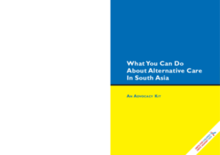Families are the natural environment for children to grow. Children have the right to be cared for by their parents; parents have a responsibility to provide for their children's upbringing and development. These concepts are not new to South Asia – children and families are a traditional cornerstone of all South Asian societies.
Yet there are millions of children in South Asia who no longer have families, who have become separated from their families, or whose families represent a serious danger to their health or development. For these children, States have the responsibility to provide special protection and assistance. Approximately one fourth of the world’s child population lives in South Asia. In 2003, there were an estimated 584 million children in the region comprising 40.6 % of the entire population. As of 2003, more than 48 million children in the region had lost one or both parents. Across the region approximately 8 percent of the total population under 18 is classified as orphans, with national estimates ranging from approximately to 6.5 percent (Pakistan and Sri Lanka) to 13 percent (Afghanistan).
There are no reliable estimates of the number of children living outside of parental care. However, analysis of proxy indicators suggests that the number is increasing. Persistent poverty, prolonged armed conflict, frequent natural disasters, the spread of HIV/AIDS, and other social and political disturbances threaten the integrity of families throughout the region.
Alternative care refers to the spectrum of services available to children whose parents no longer provide adequate care. Alternative care comes in many different forms. In South Asia, most children outside parental care live with their extended families in kinship care arrangements. Institutional care is the most common type of alternative care provided by the State. In some countries, it is the only option formally supported and recognized by the government. Other types of alternative care, such as adoption and foster care (and many other variations of family - and community-based care) are also practiced to a limited extent. In practice, these types of care and their many variants constitute a full spectrum of alternative care environments known as the continuum of care.
There are growing concerns about the situation of children outside parental care and the provision of suitable alternatives in South Asia. Attention has rightly been drawn to the South Asia region due to large increases in the number of children outside parental care. These children often find themselves at a high risk of violence, exploitation, abuse, and neglect, and their well-being is often insufficiently monitored. An inadequate care environment can impair a child's emotional and social development, and leave children extremely vulnerable to abuse and exploitation, including sexual abuse and physical violence. Institutional care has been noted as a particularly high-risk environment. The reliance of many South Asian countries on this form of alternative care has also raised cause for alarm.
On top of the millions of children already living outside parental care, many more children are at risk. Across the region, the combined impacts of widespread poverty, prolonged armed conflict, frequent natural disasters, and the spread of HIV/AIDS exert extreme pressure on families and communities, as well as on the limited social services available to support them.
In South Asia, children outside parental care and children at risk of separation are in need of protection and support. This short paper aims to provide some insight into the situation of children outside parental care in South Asia, the gaps in existing legislation, capacity, and services, with reference to national and international legal instruments, and the essential actions necessary to improve the systems responsible for providing protection and support.

